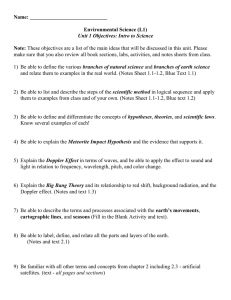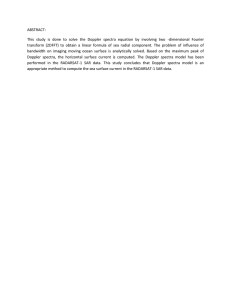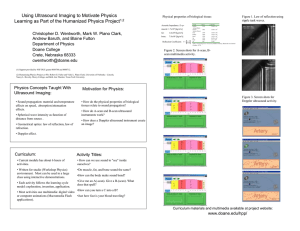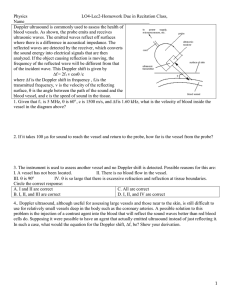Noise Immune Stethoscope - Active Signal Technologies
advertisement
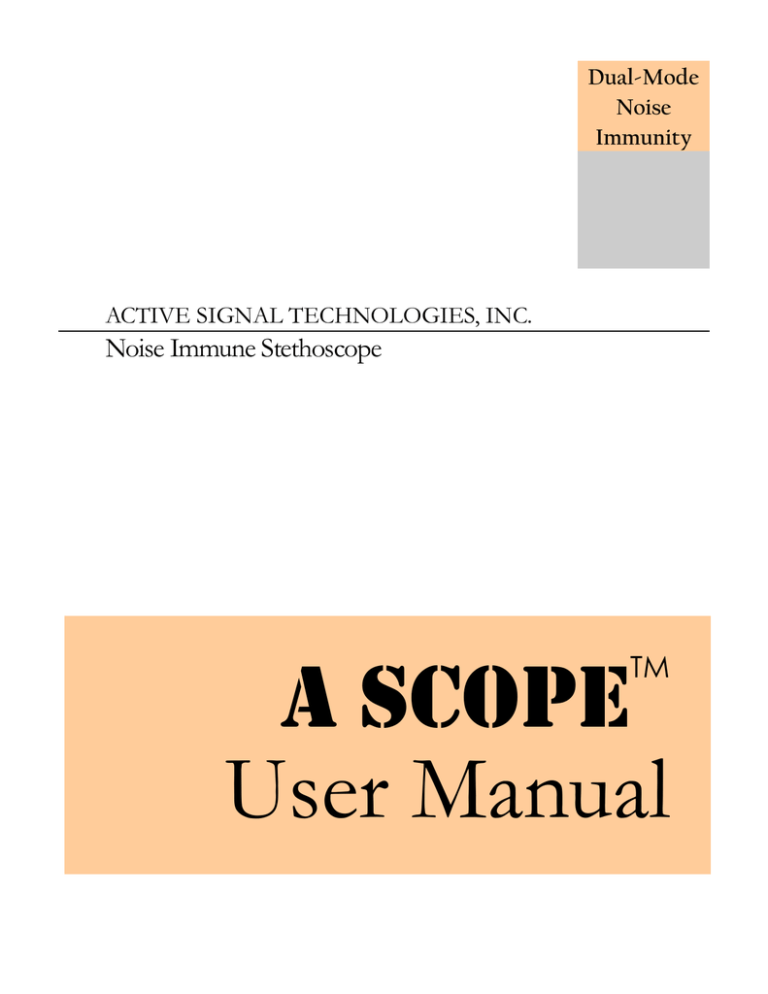
Dual-Mode Noise Immunity ACTIVE SIGNAL TECHNOLOGIES, INC. Noise Immune Stethoscope TM A SCOPE User Manual DUAL MODE AUSCULATION USING THE A SCOPETM Instructions and User Guide Active Signal Technologies Hammonds South, Unit Q 611 North Hammonds Ferry Road Linthicum Heights, MD 21090 Phone 410.636.9350 • Fax 410.636.9352 info@activesignaltech.com www.activesignaltech.com INDICATED USE The Active Signal A SCOPE (a dual-mode noise-immune stethoscope) is intended for medical diagnostic purposes only. It may be used for the detection and amplification of acoustic signals generated by physiologic activity in the body. In the presence of relatively mild ambient noise it is used in Acoustic Mode and functions as a passive electronic stethoscope to receive sounds produced by the heart, lungs, bowel and other internal organs. To retain audibility at higher background noise levels it can be switched to Doppler Mode where an audible tone corresponding to heart and lung activity is produced by the ultrasound frequency-shift caused by physiologic motion. It can be used on any person undergoing a physical assessment. It is not intended to be used for diagnosis and treatment by unlicensed, untrained, or unqualified medical persons. READ THIS FIRST User of this device should familiarize themselves with all WARNINGS, CAUTIONS and NOTES before starting operation of this device. “Warning” is the term for the words and graphics that alert the user to possible injury, death or other serious adverse reactions associated with the use or misuse of this device. “Caution” is the term for the words and graphics that alert the user to possibility of a problem with the device associated with its use or misuse. “Note” provides information to supplement the text. The following Warnings, Cautions and Notes are in this User Manual. CAUTION The user must be aware that the patient’s voice can be very loud when received through the A SCOPE in Acoustic Mode. WARNING For use in Doppler mode, in-ear speakers (ear buds, such as military communications earplugs (CEPs)) are recommended in combination with good quality circumaural hearing protectors or noise canceling headphones. WARNING Rapid gel application to the front face of the device can create a loud signal in the headset. Accordingly, when applying the gel turn down the volume temporarily or apply the gel slowly and cautiously. NOTE When the volume is set too high in Doppler Mode you will notice that the low frequency sounds will overload the headset (ear buds) and start to cut out, producing sharp discontinuities in the sounds you hear. If this happens, decrease the volume until the sound becomes continuous again. CAUTION If the Doppler gel has bubbles in it or appears frothy from movement through hair, wipe it off and apply fresh gel because the air pockets impede the ultrasound signal. CAUTION Do not store for periods longer than a week, or ship the device, with batteries in the battery compartment. NOTE The theory and application of Doppler ultrasound is beyond the scope of this manual. However, the instructions included in this manual should enable the user to detect and recognize heart and lung returns in Doppler Mode. TM Although the A SCOPE NOTE is designed to be robust and reliable, it is an advanced medical instrument and should be handled with care. TM The A SCOPE TM While the A SCOPE NOTE should be used only by personnel trained in its use. NOTE is water resistant for brief periods, it should not be immersed in fluids. NOTE TM Do not autoclave the A SCOPE . CONTRAINDICATIONS The Doppler mode of the A SCOPE is not intended for fetal use. The audible signals produced in Doppler mode do not contain the same diagnostic information as the sounds heard through a conventional acoustic stethoscope. The Doppler mode of the A SCOPETM is only intended for detection of tissue motion in the heart and lungs. SAFETY OF ULTRASOUND The American Institute of Ultrasound in Medicine has addressed concerns relating to the safety of ultrasound and has issued the following statements quoted from their website (www.aium.org) as of February 2011: Prudent Use and Clinical Safety Approved March 19, 2007 Diagnostic ultrasound has been in use since the late 1950s. Given its known benefits and recognized efficacy for medical diagnosis, including use during human pregnancy, the American Institute of Ultrasound in Medicine herein addresses the clinical safety of such use: No independently confirmed adverse effects caused by exposure from present diagnostic ultrasound instruments have been reported in human patients in the absence of contrast agents. Biological effects (such as localized pulmonary bleeding) have been reported in mammalian systems at diagnostically relevant exposures but the clinical significance of such effects is not yet known. Ultrasound should be used by qualified health professionals to provide medical benefit to the patient. As Low As Reasonably Achievable (ALARA) Principle Approved March 16, 2008 The potential benefits and risks of each examination should be considered. The ALARA (As Low As Reasonably Achievable) Principle should be observed when adjusting controls that affect the acoustical output and by considering transducer dwell times. Further details on ALARA may be found in the AIUM publication "Medical Ultrasound Safety." Active Signal has strived to use as low an ultrasound power as practical for the intended application(s). The level of ultrasound power in the A SCOPE is not adjustable and so prudent use by the operator would include minimizing the length of time that the patient is exposed to the ultrasound output. Statistical Maximum Values of Acoustic Output Ultrasound output power was measured on 3 units by an independent laboratory. All measurements were conducted in accordance with the ii measurement procedures of the NEMA Standard Publications UD-2 [i] and UD-3 [ii] using a calibrated hydrophone, and the reporting requirements of the September 9, 2008 FDA Guide [iii] for Track 1 and Track 3 devices. The following table summarizes the acoustic output values calculated from the 3 samples to be the maximum likely for 90% of all units with 90% confidence. System: A SCOPE Operating Mode: CW Doppler Transducer Model: 1109-120000-A Application: Tissue Motion Center Frequency: 2 MHz Acoustic Output Parameter: MI ISPTA.3 (mW/cm2) Global Maximum Value: 0.0373 65.4 Preamendments output exposure levels 1.9 94 Where: ISPTA.3 (mW/cm2) is the Derated Spatial-Peak Temporal-Average Intensity MI is the Mechanical Index Derated acoustic output exposure quantities were obtained from exposure quantities measured in water by multiplying by the derating factor , which is based on the measured center frequency of the acoustic signal (fc, MHz) and the distance from the transducer under test to the hydrophone (z, cm) using: e 0.069 f z . c Measurement Uncertainties The total uncertainty reported by the independent laboratory was ± 28.2 percent for the intensity value, and ± 14.1 percent for the Mechanical Index. The uncertainties comprise the stated uncertainty in the NPL hydrophone calibration, the digitizer, and spatial averaging, and a ±1ºC variation in water bath temperature. The center frequency uncertainty is ±2 percent arising from the digitizer. No non-linear distortion was observed. System Features Affecting Acoustic Output The acoustic output is set by the manufacturer and no manual or software interactive adjustments are provided on the A SCOPE. The ultrasound transducer is turned on by pressing a button and may be turned off by pressing another. The A SCOPE will automatically power down after 10 minutes of inactivity. Users are advised to minimize ultrasound exposure time by switching to passive acoustic mode whenever possible. iii Table of Contents UNPACKING THE A SCOPETM ..................................................................................................1 UNDERSTANDING YOUR NEW STETHOSCOPE..................................................................2 TWO INDEPENDENT MODES OF OPERATION ...................................................................................2 OPERATION OF THE DEVICE ............................................................................................................3 PERFORMING A MEDICAL EXAM..........................................................................................7 1. ACOUSTIC MODE: .................................................................................................................7 2. DOPPLER MODE: ...................................................................................................................7 3. GUIDELINES FOR OBTAINING THE BEST PHYSIOLOGIC SIGNALS IN DOPPLER MODE .............9 1. Device Positioning and Manipulation: .............................................................................9 2. Anatomic Locations for Doppler Auscultation................................................................11 3. General Tips for Doppler Auscultation: .........................................................................14 CARE AND MAINTENANCE ....................................................................................................15 Cleaning: ..................................................................................................................................15 Maintenance:............................................................................................................................15 Batteries: ..................................................................................................................................15 PRECAUTIONS ...........................................................................................................................17 SERVICE.......................................................................................................................................18 SPECIFICATIONS.......................................................................................................................19 A C T I V E S I G N A L T E C H N O L O G I E S Unpacking the A SCOPETM Package Contents: 1. Pelican case with foam insert 2. Headphones 3. A SCOPETM 4. Ultrasound gel 5. 4 AA batteries 6. CEPs 7. Extension cable Storage case Headset Batteries A SCOPE CEPs CEP extension cable Ultrasound gel 1 D E S I G N C U S T O M I Z A T I O N Understanding Your New Stethoscope The purpose of this instruction manual is to familiarize you with operation of the A SCOPETM dual mode stethoscope. T he A SCOPETM is a dual mode noise immune stethoscope that provides high fidelity reproduction of physiologic sounds in moderate background noise and audible Doppler returns from the heart and lungs when auscultation has to be performed in higher ambient noise. Acoustic Mode (also labeled ‘Std’ or standard) uses solid state acoustic sensing to enable very sensitive, broad band auscultation in moderate noise. Doppler Mode (also labeled ‘Dop’), used in loud conditions, reveals the presence of heart and lung function using continuous wave (CW) ultrasound frequency shifts to detect physiologic movement within the body. NOTE: the ultrasound power transmitted to the patient’s body is below typical levels used in fetal heart monitors for home use. Two Independent Modes of Operation Acoustic Mode: In this mode the device operates in a very similar manner to other electronic stethoscopes and delivers familiar physiologic sounds amplified to suit the user. In many common applications where the background noise is loud enough to make auscultation difficult with a conventional or electronic stethoscope (for example, in emergency rooms, trauma centers, accident scenes, ambulances, etc.,), the Acoustic Mode of the A SCOPETM can still generate clearly audible, high fidelity sounds, particularly if used with CEP type ear-buds and hearing protection. Doppler Mode: This mode is used at background noise levels where vital sounds are no longer audible in Acoustic Mode. The Doppler Mode provides audible returns corresponding to physiologic activity, or motion, in the heart and lungs. As such, these audible returns are not the physiologic ‘sounds’ recognizable by a conventional stethoscope user. Hence, a few minutes are needed to become accustomed to the ‘Doppler Shift’ sounds associated with ‘heart activity’ and ‘lung activity’. Because this mode employs active ultrasound, the signals are transmitted to and received from internal body organs in a high frequency band that is unaffected by commonly encountered background noise (for example, the low frequency audio noise produced by ground vehicles, generators and aircraft). Thus, if the user’s ears are properly isolated from environmental noise (using circumaural hearing protection or noisecanceling headsets) the Doppler returns can be heard clearly even when the external noise is very loud. A C T I V E S I G N A L T E C H N O L O G I E S Operation of the Device Battery compartment Center stalk finger grip Thumb control panel Front face – contacts patient Headset connector Figure 1. Major components of the A SCOPETM 1. Set up: Connect the headphones using the connector on the side of the stethoscope. If using military communications earplugs (CEPs), use the extension cable supplied to provide enough length for you to work on the patient. Figure 2. Connecting the headset cable 3 A C T I V E 2. S I G N A L T E C H N O L O G I E S Powering Up: Turn the device on by pressing either Mode Button. “Std” for Acoustic Mode or “Dop” for Doppler Mode. Power On Acoustic Mode Power On Doppler Mode Figure 3. 4-button control panel NOTE: To prolong battery life, the unit will automatically power-off ten minutes after the last time a mode button was pressed. The unit has no Off Switch. 3. Gripping the Stethoscope: Grasp the central stalk of the stethoscope between the index and middle fingers and rest your thumb over the control buttons. The wire from the stethoscope to the headset should run conveniently under your wrist. Figure 4. Holding the A SCOPETM for a patient exam 4 A C T I V E 4. S I G N A L T E C H N O L O G I E S Using the Thumb Controls: To turn the device on in Acoustic Mode momentarily press and release the button marked ‘Std’. To turn the device on in Doppler Mode momentarily press and release the button marked ‘Dop’. To adjust the volume up, momentarily press and release the button marked with the up arrow. To adjust the volume down, momentarily press and release the button marked with the down arrow. To slowly slide the volume up or down press and hold the appropriate volume button and release when the desired volume is obtained. HINT: The top and bottom buttons select the mode, i.e. Down for Doppler (button closest to the patient’s skin) and up for acoustic (button away from the patient). The farthest button from your wrist increases the volume and the button nearest your wrist reduces the volume. Mode buttons Volume up Volume down Figure 5. Position of the volume controls and mode buttons Note that the volume controls for the Doppler and Acoustic modes operate independently. Volume adjustments made in one mode will not affect the other. The stethoscope will retain its last used Acoustic and Doppler mode volume settings when stored with batteries. Whenever replacing batteries, press and hold the volume-down button for about 10 seconds in each mode, release, and then adjust the volume up by pressing the volume up button 4 or 5 times. This is to achieve a comfortable starting point for volume adjustment. 5. Volume Adjustment: Continuous volume adjustment can be accomplished by holding down the up or down button. After 1 second, the volume gradually ramps in the desired direction until the button is released. Alternatively, by momentarily pressing and releasing the up or down button the volume can be moved step-by-step over its full range of 32 steps. To move the volume control all the way up to the maximum press and hold the volume up button for 10 seconds. To move the volume control all the way down to the minimum press and hold the volume down button for 10 seconds. 5 A C T I V E S I G N A L T E C H N O L O G I E S The audio output amplifier in the A SCOPETM is designed to drive a wide variety of devices such as headphones, communications earplugs (CEPs), or other similar devices. To do this it needs to be capable of driving these diverse devices with sufficient power to effectively and accurately reproduce the physiologic sounds. This means that the amplifier is also capable of overloading some of these devices if the volume is set high enough. Care must be taken by the user to avoid overload conditions. Overloading does not cause any damage, but it can cause the audio output to appear to be limited or attenuated. The user may respond to this attenuation of the signal by increasing the volume, driving the output device further into overload. 6. Shut Down: When you have completed the exam remove the headset and unplug from the stethoscope. Wipe off any remaining gel from the front face or sides of the stethoscope. Wipe down the entire stethoscope with a germicidal wipe approved for hospital use just as you would with a conventional stethoscope. If wipes are not available, the device can be wiped down with a soft cloth or tissue dipped in rubbing alcohol. 7. Switching the stethoscope off: The unit has no power button. Instead it will time out (power off) approximately ten minutes from the last time a mode button was pressed. However, the volume settings will be preserved from the moment it powered down. 8. Storage: When the unit is not in use, return it to its protective case and stow properly. If the unit will be stored for more than a week, remove the batteries and keep them separately in the storage case. 6 A C T I V E S I G N A L T E C H N O L O G I E S Performing a Medical Exam 1. Acoustic Mode: In mild noise and quiet settings, the over-the-ear headset provided with your A SCOPETM is recommended. Connect the headset to the stethoscope by pushing the small metal female SMB connector firmly onto the recessed male connector in the housing (Figure 2). Place headphones over the ears, then momentarily depress and release the ‘Std’ button on the control panel to power up the device. Grasp the stethoscope by inserting your index and middle fingers on either side of the central stalk (Figure 4) and rotate the device until your thumb rests comfortably over the four button control panel. The wire to the headset will run under your wrist and should not interfere with your patient exam. In the Acoustic Mode, the physiologic sounds you hear with the A SCOPETM should sound much the same as your conventional or electronic stethoscope. Your auscultation locations and procedures in this Mode will be unchanged from well established medical practice. Listen in a few representative locations and adjust the volume to a comfortable level. You may find that you can increase the volume more than you can with other electronic stethoscopes and retain clarity because there is less noise and distortion in the signal. CAUTION However, be aware that the patient’s voice can be very loud when received through the A SCOPETM in Acoustic Mode If it is uncomfortable when the patient talks, request silence or remove the stethoscope from the skin until the conversation is over. The volume will hold at whatever level you set until you adjust it, even after the device switches itself off. While in acoustic mode you will find that the device will allow you to hear clearly in moderately noisy environments that might otherwise make auscultation difficult. Under these conditions, some clinicians find that the acoustic signal can be improved by pressing the front face more firmly into the skin. Beyond this, you should not notice anything different compared to your old familiar stethoscope. 2. Doppler Mode: When auscultation in Acoustic Mode becomes too difficult because of intrusion by external noise, you will need to switch to Doppler Mode. Typically this becomes necessary at ambient noise levels between 80 and 95-dB depending on the user’s hearing, the type of headset and the strength of signals sensed on the patient. 7 A C T I V E S I G N A L T E C H N O L O G I E S WARNING Under these conditions, in-ear speakers (ear buds, such as military communications earplugs (CEPs)) are recommended in combination with good quality circumaural hearing protectors or noise canceling headphones. Hearing protectors CEP Extension cable Figure 6. Doppler returns are best heard using in-ear ear buds or CEPs combined with a circumaural hearing protector or a helmet with integrated hearing protection Connect the headset to the stethoscope by pushing the small metal female SMB connector firmly onto the recessed male connector in the housing (Figure 2). Insert ear-buds into ears in accordance with manufacturer’s instructions. Place hearing protectors over the ears and ear buds (Figure 6), and push the ‘Dop’ button on the control panel (closest from the patient’s body) to power up the device (Figure 3). Apply a generous amount of ultrasound gel to the front face of the A SCOPETM. A dollop that covers the area of a quarter on the center of the face is sufficient (Figure 7). Figure 7. Ultrasound gel on front face of the A SCOPE 8 A C T I V E S I G N A L T E C H N O L O G I E S WARNING Rapid gel application can create a loud signal in the headset. Accordingly, when applying the gel turn down the volume temporarily or apply the gel slowly and cautiously. The Doppler ‘frequency shift’ sounds you hear with the A SCOPETM will not sound like the physiologic sounds picked up in Acoustic Mode (or the sounds from a conventional or electronic stethoscope). You will therefore need to familiarize yourself with the frequency shift sounds produced by lung motion and heart motion. Practicing on yourself or on a volunteer is recommended before working on a patient. Some of the frequency shift sounds may sound faint, muffled, or seem to be in a frequency range that is lower than you are accustomed to, particularly when examining the lungs. Practice adjusting the volume to bring the sounds out more clearly from other artifacts in the signal. NOTE When the volume is set too high you will notice that the low frequency sounds will overload the headset (ear buds) and start to cut-out producing sharp discontinuities in the sounds you hear. If this happened, reduce the volume until the sound becomes continuous again. 3. Guidelines for Obtaining the Best Physiologic Signals in Doppler Mode 1. Device Positioning and Manipulation: As with any Doppler ultrasound device, positioning is critical and requires a little selfteaching before working on a patient. The following hints apply to both heart and lung auscultation of the chest in Doppler mode. The device will not pick up any signal from internal organs if it is located over bone because the bone reflects most of the transmitted ultrasound back into the device. Accordingly, for thoracic exam the center of the front face of the A SCOPETM needs to be located over the mid point of the intercostal space in the region being examined. In addition, the prominently marked diameter line on the battery cover must be aligned parallel to the length direction of the intercostal space. This line separates the Doppler transmitting and receiving elements both of which must ‘see’ the intercostal space. In some cases a good signal can also be obtained perpendicular to this direction, but generally not in any intermediate orientations. 9 A C T I V E S I G N A L T E C H N O L O G I E S IN DOPPLER MODE ALIGN WITH INTERCOSTAL SPACE Diameter line on cover should be parallel to intercostal spaces ACTIVE SIGNAL TECHNOLOGIES 611Q N. Hammonds Ferry Rd Linthicum Heights, MD 21090 Ph. 410 636 9350 www.activesignaltech.com Figure 8. Decal and alignment mark on battery cover Note steep slope of ribs and intercostal spaces Figure 9. Lateral view of thorax showing rib orientation Locating a good listening point may require a few different adjustments. These become rapid and instinctive with practice: (i). Try more than one intercostal space in the region of interest (ii). Reposition the head by sliding the A SCOPETM along the length of the intercostal space (iii). Make small adjustments to the angle of the front face to the body by rocking the device - pushing slightly harder on one side or the other of the diameter line on the battery cover (iv). Recheck the precise orientation of the ribs (and intercostal space) with your fingers. Rotate the A SCOPETM until the line on the battery cover is precisely parallel to the ribs 10 A C T I V E (v). 2. S I G N A L T E C H N O L O G I E S Even when you have located a good spot for listening this can shift with time because the gel-covered face may move slightly out of position. Be prepared to optimize the location and orientation again. Anatomic Locations for Doppler Auscultation Lung Function: With a conventional stethoscope, lung sounds are associated with air movement through different size tubes and cavity resonances, and present well in particular locations. These are not necessarily the same places where gross lung motion due to breathing can be detected. However, as with conventional acoustic auscultation of the chest the patient has to take deep breaths to provide a satisfactory signal. Some good starting points for the exam are shown in Figure 10 and Figure 11. Posterior axillary line Anterior axillary line Area with strong Doppler returns Mid axillary line Figure 10. Lateral view of thorax showing optimum area for Doppler auscultation in red 11 A C T I V E S I G N A L T E C H N O L O G I E S Area with strong Doppler returns Figure 11. Anterior and posterior views of thorax showing optimum positions for Doppler lung returns shaded in red 12 A C T I V E S I G N A L T E C H N O L O G I E S The region below the armpit between the posterior axillary line and the anterior axillary line (Figure 10) can often be accessed on an injured patient and yields Doppler returns in the area shaded in red. Note that the ribs are typically sloping steeply downwards in this area with respect to the mid axillary line. Be sure that the marker line on the battery cover is parallel to the slope. Alternative areas of the lung for detecting Doppler returns are shown in Figure 11 -- lower portion of the lung approached from the front of the patient, and lower portion of the lung approached from the back of the patient. Doppler returns from the latter two areas may not be as strong as along the mid axillary line. As discussed above, breathing / lung Doppler returns may not seem very distinct and can be fairly deep in tone. They are best heard with in-ear speakers (ear buds) with complete isolation from ambient noise (hearing protectors), even when used in a relatively quiet room. The typical Doppler return from the lung has been described as similar to a ‘cardiac rub’ heard with a conventional stethoscope. Heart Function: With a conventional stethoscope, heart sounds are produced by periodic filling and discharge of boluses of blood and movement of physiologic components of the valves. Some of these gross motions can also be detected in Doppler Mode. The strongest Doppler returns can generally be obtained near the apex of the heart (the area used for mitral valve auscultation with a conventional stethoscope). However, Doppler returns can also be detected over the aortic, pulmonary and tricuspid valves (Figure 12). Figure 12. Conventional locations for acoustic auscultation of the heart 13 A C T I V E S I G N A L T E C H N O L O G I E S 3. General Tips for Doppler Auscultation: 1. Be patient finding a good location and correctly orienting the stethoscope 2. Check the front face often to be sure it remains well coated with Doppler gel 3. Avoid air bubbles CAUTION If the Doppler gel has bubbles in it or appears frothy from movement through hair, wipe it off and apply fresh gel because the air pockets impede the ultrasound signal 4. Starting at a low volume setting (3 to5 steps from the lowest setting) can make it easier to home-in on the physiologic Doppler return with less distraction from artifact and noise. It is better to increase the volume after a good location has been found. 14 A C T I V E S I G N A L T E C H N O L O G I E S Care and Maintenance Cleaning: The unit should be cleaned externally with alcohol as needed and returned to the case. Alternatively, cleaning can be performed with germicidal wipes approved for hospital use. Maintenance: The A SCOPETM has been designed to operate for many years without adjustment or maintenance. Because the device is custom assembled, tuned and calibrated in the lab, no field maintenance or adjustments should be attempted by the user. If the device fails to operate as expected at any time, please return to Active Signal Technologies for repair. Instructions for return are provided in the Service section of this manual. Batteries: TYPE: The unit uses two standard AA alkaline batteries. BATTERY LIFE: In continuous use with a typical mix of Acoustic and Doppler examination the batteries should last for ~60 hours. There is no battery life indicator and no warning about low batteries. When the batteries are drained the unit will go silent and will not respond when any of the buttons on the control panel are pushed. STORAGE AND SHIPPING Do not store for periods longer than a week or ship the device with batteries in the battery compartment. 15 A C T I V E S I G N A L T E C H N O L O G I E S CHANGING THE BATTERIES: If at any time the stethoscope ceases to work, the first thing to try is replacing the batteries. To do this, turn the cap counter-clockwise to access the battery compartment (Figure 13). O ring Figure 13. Accessing and replacing the batteries Figure 14. Battery cover unlocked………………… battery cover locked With the cap removed, inspect the O ring between the housing and the cap. If it is damaged, replace it. Remove both batteries (never mix new and used batteries) and replace with fresh batteries taking care to observe the correct polarity. Replace the cap by aligning the white line on the side of the battery cover with the white dot on the housing. Push into place and rotate clockwise to engage the keep. You should hear a faint click when the keep engages. Replacement of the batteries resets the volume to default settings (50%) and power to off. Accordingly, after replacing batteries, hold down the volume-down button for about 10 seconds in both modes, and then adjust the volume up to 5 steps in both modes. This provides a good starting point for adjusting volume the next time the stethoscope is used. 16 A C T I V E S I G N A L T E C H N O L O G I E S Precautions The instructions included in this manual should enable the user to detect and recognize heart and lung returns in Doppler Mode. However, the theory and application of Doppler ultrasound is beyond the scope of this manual. Although the A SCOPETM is designed to be robust and reliable, it is an advanced medical instrument and should be handled with care. The A SCOPETM should only be used by personnel trained in its use. While the A SCOPETM is water resistant, it should not be immersed in fluids Do not autoclave 17 A C T I V E S I G N A L T E C H N O L O G I E S Service Service Information and assistance is available from: ACTIVE SIGNAL TECHNOLOGIES INC. HAMMONDS SOUTH, UNIT Q 611 NORTH HAMMONDS FERRY ROAD LINTHICUM HEIGHTS, MD 21090-1322 PHONE. 410 636-9350 www.activesignaltech.com email: info@activesignaltech.com It you need to send a unit back for repair, please call the above number to get a return authorization number (RA#). Please have available: 1. Serial number (label located next to the battery holder) 2. Name, phone number, e-mail address of the person using the A SCOPETM when it failed 3. Name, phone number, e-mail address of the person responsible for setting up this RA 4. Addressee and return address for shipping the repaired A SCOPE 5. Information about the nature of the problem with the device including circumstances of the failure and symptoms observed Package the product with good cushioning (in its original container if possible) and return it to the above address: Ship the product, insured via any major national carrier. In your return package please include the assigned RA number, the contact information in items 2., 3. and 4., above, and a written description with as much detail as possible about the nature of the problem with the device including circumstances of the failure and symptoms observed For service outside of the United States, please contact the local representative from whom you purchased the unit. 18 A C T I V E S I G N A L T E C H N O L O G I E S Specifications Mechanical and Electrical Modes 1. Passive Acoustic 2. Continuous Wave Doppler Ultrasound Doppler frequency: 2.1 MHz +/-10% Maximum ultrasound power: <90 mW/cm3 Physical dimensions Weight: 340 grams (0.74 lb)* (* including batteries) Height: 3.2 inches Diameter: 2.6 inches (largest dimension) Type: User replaceable Alkaline Voltage: 1.5 volt Size: AA Batteries Power off : ~9000 hours (~1 year) Acoustic mode: 120 hours (~5 days)** (** minimal audio output) Doppler mode: 45 hours (~2 days)** Audio power amplifier Power : 1.4 Watts into 8 ohm load THD: 0.19% (typical @ 0.5W) Efficiency: 84% @ 400 mW Frequency response: 5 Hz – 20 KHz Typical continuous operation battery life Environmental Limits Temperature: Operating temperature range with batteries: -20°C to +55°C. Storage temperature range with batteries: -20°C to +35°C. Storage temperature range without batteries: -65°C to +150°C. Humidity: 5% to 95% noncondensing (operating the device in Operating humidity range: humidity above 95% and in condensing environments is allowed but exposure time should be limited) 5% to 95% noncondensing. Storage humidity range: Altitude: Operating altitude range: 0 to 40,000feet. Storage altitude range: 0 to 60,000feet. This device may be damaged by sudden decompression at high altitude. User manual Part # xxx-xxxx-xxx-xx Version -005 19 A C T I V E S I G N A L T E C H N O L O G I E S i "Acoustic Output Measurement Standard for Diagnostic Ultrasound Equipment, Revision 3," NEMA Standard Publication UD-2, National Electrical Manufacturers Association, 2004. ii “Standard for the Real-time Display of Thermal and Mechanical Acoustic Output Indices on Diagnostic Ultrasound Equipment, Revision 2” NEMA Standard Publication UD-3, National Electrical Manufacturers Association, 2004. iii "510(k) Guide for Measuring and Reporting the Acoustic Output of Diagnostic Ultrasound Medical Devices," Center for Devices and Radiological Health, FDA, 1985, and revised in 1989, 1990, 1991, 1993, 1994, 1997, 2008. 20
